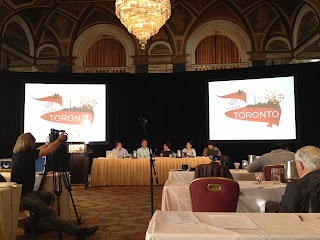Tuesday, August 16, 2022
Sunday, May 03, 2015
This is what Guy looked like when I first met him in Yellow Springs, lugging his guitar and a slide carousel.
Guy Carawan has died. I met
Guy at Antioch in 1958. He was passing through and had recently returned from a
trip to China. I was Activities Director (a student government position) and
had a budget and was able to pay him an honorarium and set up a screening of
his slides from Mao’s China in the old gym. it was packed. China was a mystery
in those days. It was before Lucy Jarvis took NBC there. Even before Felix
Greene had made his film or published his books. A slide show from this
forbidden territory caused a big stir in middle Ohio. People came from Dayton
and even Cincinnati. It was one of my biggest “activities”.
Guy liked
listening to my partner Mahlon’s banjo and took to it like a fish to water. It
replaced his guitar as his signature instrument. Guy and me and Alice Foster
(Gerrard) and I think it was Joan Goodman crammed into a tiny VW bug and headed
south to Highlander one weekend from Yellow springs.
Highlander was a civil
rights training center where Rosa Parks, Septima Clark, CT Vivian and many
other leaders met and held strategy workshops. I had been there many times
while in high school in Chattanooga and wanted to share the experience with my
Antioch friends. Guy had been there in 1953 and was anxious to see it again. We
had a great time. It wasn’t a workshop weekend, so we spent time listening to
Myles Horton telling us mountain stories and helping the cook Dodie shell peas
to freeze. And of course Dodie and Guy traded songs. Later that very month
Highlander was raided and shut down for “selling liquor without a license”
because of the donation can near the six packs in the frig. Grundy Country was
dry, even though The University of the South down the road was the drinkingest
college in the country. The informer apparently was that same Dodie, the cook.
As
years passed, I saw Guy several times in New York whenever he came for a
concert and once I helped him edit a video of a Highlander music workshop, Come
All You Coal Miners, which had been shot on reel to reel tape. We edited at EAI
at their place on 5th ave. I last saw Guy and Candie, his wife, at the New
Market Highlander when I was there for a media activism workshop. Guy leaves
many recorded songs, several books (my favorite is “Ain’t you gotta Right to
the Tree of Life?”about the Georgia Sea Islands) and a lovely tape by his
daughter Heather, The Telling Takes Me Home.
|
Labels: Alice Gerrard, Antioch, CT Vivian, Felix Greene, Georgia Sea Islands., Guy Carawan, Highlander, Lucy Jarvis, Rosa Parks, Septima Clark
Saturday, January 26, 2013
Monday, October 15, 2012
My Visit to the Toronto ICANN Conference
Labels: Africa, Domain Take Down, GAC, ICANN, IP Justice, Law Enforcement, Milton Mueller, NCUC, Rafik Dammak, Robin Gross, Toronto
Friday, October 05, 2012
"We've Come from the City!"
Labels: Camp Woodland, Catskills, Communist, Herbert Haufrecht, Hudson Valley Folk Guild, New York, Parish Hall, Phoenicia
Friday, September 21, 2012
Waiting for the Invasion in 1983
Labels: Central America, Eddie Becker, Grenada, invasion, Joan Braderman, Karen Ranucci, National Security Administration, Nicaragua, NSA, Peter Rossett, Sandinista, Sandino, Skip Blumberg
Thursday, August 16, 2012
Wednesday, July 18, 2012
Camp Woodland Reunion
Sue Rosenberg reads from Camp Woodland's newspaper, The Catskill Call and Pete sings Guantanamera.
Pete Seeger explains the origen of the poem Guantanamera, which was written in Haines Falls, NY state, where the great Cuban poet was recuperating from illness.
Atheists and Patriots:
Campers speak of their camp experiences-- from arguments about the existence of God to raising the US flag every morning.
Niela Miller Sings Searching for the Lambs.
Putting on the Agony, Putting on the Style
Last Night I had the Strangest Dream followed by Down by the Riverside
Two songs from the Cantata "We Come From the City" by Herb Haufrecht sung by the Hudson Valley Folk Guild.
Sue Rosenberg sent more information about the musicians:
So here are the names of the people on the stage:
Eric Weissberg on the banjo, playing with him was Mickey Vandow.
Karl Finger played guitar and he's the one singing Guantanemara with Pete and Pat Lamanna.
Niela Miller was all the way on the right (near me) and Dan Mack-Ward was the other guy with the guitar. He sang When a Feller is out of a job. Bob Lusk from Heritage Folk Music sang Big Bill Snyder with Ira McIntosh- who is the story teller from Andes.
I will be posting these songs in the next few days.
It takes time to compress the material and then to post it on YouTube.
DeeDee Halleck
Labels: atheists, camp, Camp Wooodland Reunion, patriotic, Pete Seeger, progressive, radical, Sue Rosenberg
Saturday, July 14, 2012
Friday, July 13, 2012
Paper Tiger Clean Up Unearths Trove of Rare Media Journals

Patricia Gonzalez, Rebecca Centeno and Tomoko Abe on Clean Up Day
The Paper Tiger office is getting reshuffled and we found collections of several magazines that I refused to put on the street! I know everything is digital, but I thought that surely there are people who might want to have in their archive.
If you are interested, call me (DeeDee 845 594 4871) and I will deliver to any place within the metropolitan area.
Afterimage-- many issues from the early 1980s
Community Television Review--1984 on for several years
Channels of Communication-- EARLY 80S
CINEASTE -- 1979 on for several years
Kick It-- unusual Australian magazine from th early 90s
Cultural Correspondence-- 1983 , 1984
Colors- some of the early issues 1995
Off Our Backs 1980s
Sojourners--1980s
Mom Guess What 1980s
Nacla 1984 for many years-- great Latin American journal
Extra 1995 on-- lots of issues.. great journal from FAIR
Don't let these end up on the street!
call or email: deedeehalleck@gmail.com
Great for Media Literacy Classes
Labels: Afterimage, CINEASTE, CTR, EXTRA, NACLA
Sunday, April 29, 2012
REMEMBERING SHIRLEY CLARKE
At any given time there always seemed to be one or two Japanese dancers around. Sometimes even Andy Warhol climbed that flight of stairs after the last elevator stop, looking for Viva. Louis Malle came by, as did Susan Sontag, Joris Ivens, Peter Brooks, Jean Rouche and Shelly Winters. The Chelsea had a certain cachet for visitors from Europe, Hollywood and Japan and Shirley was queen of the Chelsea.
Workshop Photographs by Peter Simon Shirley kissing Nam June photo by DeeDee Halleck
AND HERE IS SHIRLEY IN ACTION: AN INTERVIEW WITH NOEL BURCH AND OTHERS (INCLUDING RIVETTE!)
Labels: Agnes Varda, Andy Gurian, Andy Warhol, Bruce Ferguson, Chelsea, DeeDee Halleck, Felix the Cat, Frederick Wiseman, Harry Smith, Peter Simon, Shirley Clarke, Shrider Bapat, Vicki Polon, Viva
Wednesday, April 25, 2012
Michael Ratner on Bradley Manning's "Trial"
Saturday, March 24, 2012
Paper Tiger Exhibition at NYU Library
AN INTERVIEW WITH DEE DEE HALLECK FROM PAPER TIGER TELEVISION
Filed under: Exhibition, New York City, television, Activism | Tags: Lucas Green, Dee Dee Halleck,Paper Tiger Television

Citywide aims for progressive programming. We bring many people onto the show who stand to make a change in the world in whatever way they strive to do. This can take place in a number of different ways. Some of our guests are out there trying to improve conditions for less privileged parts of our society as well as spreading a humanitarian message, see our post on Immortal Technique. Some of our guests are actively trying to expand on what the human being can physically be, like recent guest Genesis Breyer P-Orridge. Some of our guests have represented a change itself in being an original artist, like Mykki Blanco who was on last month.
These are people our program has brought on for our audience to check out and have something different to think about. Paper Tiger Television, our feature this week, is another weekly program in the City which doesn’t just discuss the people who are doing progressive work this day, the people on the show itself have been pioneering and innovative since the show’s formation in 1981. PPTV recognizes that there must be an aggressive front to counter a mainstream media that is largely controlled by large corporations. Formed entirely by volunteers who share the concern of what control mass media has over today’s culture, PPTV has been one of the most consistent and driven organizations of people who insist that there be a source of criticism and information outside the commercial world.
I spoke with one of the founders of Paper Tiger Television, Dee Dee Halleck, who took me through some of the early years of the new form of media activism which PPTV represented at the beginning of the 1980s. It is important to note about PPTV that while that not only did they set a new precedent for activists trying to reach a mass audience, they also set an important precedent for the mediums of public cable television which was just emerging at the time. And while programs such as The Coca Crystal Show and Glenn O’Brien’s TV Party (“The TV party that could be a political party”) had already fought to claim the medium as one belonging to the people, PPTV ensured that the medium would balways be used to also speak for the people.
It’s an extraordinary organization that continues to do extraordinary work. Greatest of all is that they are always accepting volunteers. Check out their website and see what you think about the work they do; see if maybe you even want to help. You can also watch many of the programs tand documentaries they have produced. That’s righthere.
PPTV is currently celebrating it’s 30 year anniversary with an exhibition at Fales Library at New York University. This is the exhibition’s website. Here is a video about the 30 year history of Paper Tiger Television-
Dee Dee Halleck also told me about a great new effort of hers to unite activists with similar causes around the world. Check out Deep Dish Waves of Change for more information about that. This program derives from another project of Dee Dee’s calledDeep Dish TV, a similar organization to PPTV, doing with satellite what Paper Tiger did with cable television.
Dee Dee told me some wonderful stories herself. Check out the interview here-
Here is one of the first PPTV programs, Herb Schiller reads the New York Times-
Lucas Green
Labels: activism, Alternative Media, City Wide Radio, community media, DeeDee Halleck, Fales Collection, Herb Schiller, Lucas Green, Mary Feaster, NYU, Paper Tiger TV, Public Access


























